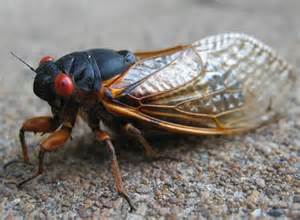
by Rick O'Connor | Jul 24, 2015
I was sitting on my back porch late in the afternoon this past week enjoying the breeze and the sunset when the familiar sound of the bugs some call “locust” began their buzzing songs. Not all would agree with me but I really enjoy the sound of these animals. They remind me of camping and warm summer evenings, they remind me of living in Florida. They have been with me all of my life and I quite enjoy hearing them – would actually miss them if there were not here.
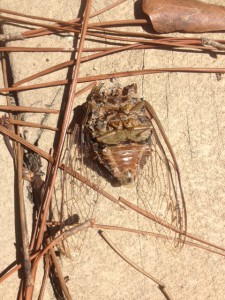
The adult body of a local cicada.
These bugs are not locust but a type of insect called cicadas, which is different from the “katydid” which is a different insect all together. Many who have grown up in Northwest Florida are quite familiar with their songs but not with the insect itself. Cicadas begin their lives in the trees – this is where the females lay their eggs. Most of them will find a split or tear in the twig tissue but others will actually make such a tear and here deposit their eggs. When they hatch they fall to the ground as an ant-sized larva. These larva burrow under the ground and move via burrows feeding on the sap and tissue of plant roots. Some species spend 2 years here, others as many as 17 years before they emerge. Like all members of Arthropoda these insects have external skeletons and must molt, or shed them, as they grow. Cicadas molt three times while living beneath the soil before emerging as a nymph. The nymph will climb a tree where they will molt once more becoming the winged adult some of us have seen. Many have found the empty cast of these molting nymphs clinging to the side of the tree. The males do most of the “singing” using drum-like structures called TIMBALS along their abdomen. These timbals are controlled by muscles and vary from species to species. The songs are species specific and are used to communicate with others but particularly the females, with whom he wishes to breed with before their lives come to an end in a few weeks. Landscapers and contractors have claimed that the sounds of their lawn equipment and power tools will sometimes attract cicadas and there is some evidence that it in fact it does… particularly females.

The empty molt of a cicada nymph.
There are many species of cicadas in the United States. One group will lay their eggs, the larva will drop and remain subterranean for 17 years emerging all at once! There are 19 species found in Florida and the mass emergence does not occur here. Our adults emerge every season, singing their songs, and relaxing our souls. I am glad they are here. Enjoy the summer.
by Les Harrison | Jul 18, 2015

A room with a view: a stripped hermit crab sizes up a potential residence
Summertime in north Florida is good. Among the premium experiences are leisurely hours at the beach.
For many this is a period of relaxation and the opportunity to casually examine what the surf has thrown on the beach. It can be the culmination of a summer vacation or a weekend reprieve from the contemporary insanity of 2015’s workaday grind.
The hermit crab is one commonly encountered native creature which is slow-moving and hard to miss observing. It scuttles along the shallow coastal waters in search of its immediate needs.
In most cases it is the next meal which prompts this member of the Pagurus genus to fitfully crawl about in the borrowed disguise of a gastropod. They are not particular which shell they occupy just so long as it fits their size and is transportable.
Likewise, they are not especially particular about their meals. Hermit crabs are omnivores which relentlessly scavenge for anything digestible in the shallow waters of much of the world.
Their family includes about 1100 members which differ in size, color and housing choices. Some, in other regions, will even lodge in immovable locations and depend on the tidal currents to provide for their nutritional requirements.
When times are good and the hermit crab has plenty to eat, it will outgrow it’s the shell which fate provided for its use. The search for a replacement requires probing, luck and can produce aggressive behavior between hermit crabs if appropriately sized shells are in short supply.
Without the shell a hermit crab is an easy meal for other denizens of the deep. If the shell is too small, the hermit crab cannot grow properly or withdraw into the shell completely which exposes it to the unending stream of predators.
The upper portion of their bodies is covered with a hard exoskeleton, but their abdomen is soft and vulnerable to attack. The long and pliable abdomen is useful for firmly holding to a vacant snail shell which provides the necessary protection.
The technique has proven very successful for the hermit crabs as a whole. Fossil records indicate these crustaceans have existed since the last days of the dinosaurs.
While hermit crabs live alone in the shells they procure, they are commonly found in colonies and compete for a variety of necessary resources and mates. Their collective activity has attracted the attention of many young beach goers.
The small, shy creatures have held unending fascination for generations of children. The hide and seek nature of their behavior retreating into shells at the first appearance of a threat increases the enticement.
The temptation to return home with a unique and diminutive pet has proven irresistible for many. One can only guess how many parents have first learned of their child’s decision by the aroma of a deceased hermit crab.
It is a good thing the visit to the beach is relaxing. To learn more about hermit crabs contact the nearest UF/IFAS Extension Office.
by Les Harrison | Jul 18, 2015

Osprey nesting sites are commonly near water, and their food source.
In north Florida water sports are a supreme pastime in summer. Fishing is among the most popular activity for all ages in this recreational realm.
Human anglers are not the only competitors seeking to land a trophy specimen. Ospreys, the local avian apex fisher, are literally plucking the fish from every river and body of water in the region.
Pandion haliaetus carolinensis is one of four osprey species worldwide and is native to north Florida. Geologic records in the area indicate a long residency and the possibility of extinct members of this genus who once lived in prehistoric Florida.
This aquatic predator is easily identified because of its size and nesting habits. Large specimens can have a six foot wingspan and their big nest are usually located in the tops of trees near a body of water.
The backs and wing tops of this bird are dark brown, but its underside is a snowy white. The head is white with a dark band over the eyes which gives the appearance of a mask.
Males and females are very challenging to distinguish individually as there are only small variations in their size and feather coloration. Side by side it is easier to see the difference in wing shape and body size.
As the several common names imply, the osprey’s diet is comprised of fish almost exclusively. Salt water catfish, mullet, spotted trout, shad, crappie and sunfish are some of the prey which stray into this bird’s sight when they swim too close to the water’s surface.
Osprey’s have the ability to hover in a nearly stationary position 100 feet or more above the water as they wait for their prey to move into the ideal position. When the fish is most vulnerable this bird drops almost vertically and securely clutches the fish in its talons.
Ospreys and owls are the only raptors, birds of prey, whose outer toes are reversible and which provide a highly effective gripping ability. A slippery fish is much less likely to escape when grasped by two talon-tipped toes on each side of the foot.
Their nest are large structures constructed of sticks. Ospreys commonly mate for life and will reuse nest for many years.
Utility poles, channel markers and other manmade locations with plenty of ground clearance and good visibility can be used by ospreys for nesting. Electrical power lines have proven problematic in a few cases if the birds contact the charged line and a grounding source.
Ospreys can be observed all year in Wakulla County and north Florida, especially near water bodies and shorelines. It is a safe bet they will leave with a good catch
To learn more about ospreys in north Florida contact your local UF/IFAS Extension.
by Judy Biss | Jul 18, 2015
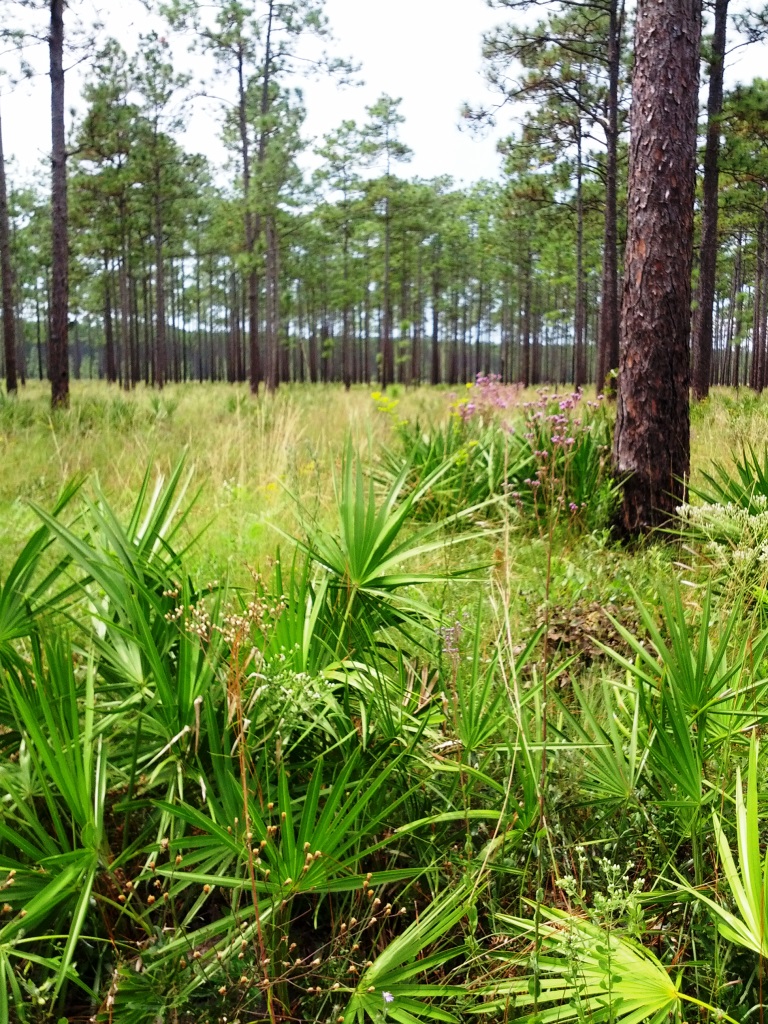
Woodlands and rangelands are important to both our economy and environment. Photo by Judy Ludlow
Most of us living in panhandle Florida recognize that our farmers and ranchers are committed to sustainable production of food, fiber, and fuel for generations to come, but how will farmers continue to be productive while sharing natural resources with an ever growing population and an intricate environment? How will Florida’s agricultural lands, rangelands, and woodlands continue to contribute to the quality of our environment and to our economy?
Florida Rangelands:
According to the USDA Natural Resources Conservation Service “Range and pasture lands are diverse types of land where the primary vegetation produced is herbaceous plants and shrubs. These lands provide forage for beef cattle….and other types of domestic livestock. Also many species of wildlife…depend on these lands for food and cover.” Florida’s rangelands and woodlands are a significant component of Florida’s agricultural industry.
According to the 2012 Census of Agriculture there were:
- 3,749,647 acres of permanent pasture and rangeland in Florida
- 1,368,171 acres of pastured woodland in Florida
Benefits of Rangelands:
Florida’s 5.1 million acres of agricultural rangelands and woodlands not only support the economy, but abundant wildlife too. These well managed lands are living systems sustaining livestock, wildlife, and healthy soils. Benefits of these lands include important economic and ecological services like reducing our carbon footprint, increasing water conservation, providing forage for livestock, habitat for wildlife and game, preservation of cultural heritage, and sustainable timber. Additionally, hunting, fishing, and wildlife viewing is a multi-billion dollar industry within which Florida’s rangelands play a significant role. Florida’s rangelands are also important for the continued survival of many threatened species like the Crested Caracara, Snail Kite, Gopher Tortoise, Florida Scrub-Jay, Eastern Indigo Snake, Roseate Spoonbill, Wood Stork, and Sandhill Cranes.

Gopher Tortoise. Photo by Chuck Bargeron, University of Georgia, Bugwood.org

Sandhill Cranes in a North Florida pasture. UF/IFAS Photo by Josh Wickham.
Challenges to Florida’s Rangelands:
Threats to Florida rangelands include conversion into urban areas and fragmentation of large tracts of lands causing disconnection from other farmlands and natural areas. Contiguous, connected “wildlife corridors,” are important for many species of wildlife. Additionally, the establishment of non-native, invasive animals and plants; and alterations of natural and necessary processes such as fire, floods, and droughts, can disrupt the full economic and environmental potential of these lands.
Agricultural Best Management Practices and Education:
Today’s farmers use best management practices (BMPs) relying on up-to-date technologies and research to protect Florida’s unique natural resources, especially our precious water, while at the same time maximizing their production. BMPs are based on University of Florida Institute of Food and Agricultural Sciences (UF/IFAS) research and are practical, cost-effective actions that agricultural producers can take to conserve water and reduce the amount of pesticides, fertilizers, animal waste, and other pollutants entering our water supply. They are designed to benefit water quality and water conservation while maintaining or even enhancing agricultural production. According to the Florida Department of Agriculture and Consumer Services, for example, agricultural producers save 11 billion gallons of water each year by their conservation practices.
Many of Florida’s rangeland and woodland owners also take advantage of educational programs available to them such as the UF/IFAS Forest Stewardship Program. The mission of this multi-agency program is to help and encourage private landowners to manage their lands for long-term environmental, economic, and social benefits. According to their annual report: “In 2014 the Program reached 503 landowners and professionals directly with workshops and field tours. These landowners and professionals collectively own and/or manage over 2 million acres across Florida.”
Summary and Additional Resources:
Florida’s agriculture producers are deeply committed to being stewards of their lands and our surrounding environment. Their adoption and support of best management practices as well as continuing education is critical for sustainable production and also for feeding the world of the future.
For more information on this topic please see the following resources:
UF/IFAS Forest Stewardship Program
UF/IFAS Extension – Range Cattle Research and Education Center
UF/IFAS Extension – Best Management Practices
Florida Farm Bureau’s County Alliance for Responsible Environmental Stewardship Program (This Farm CARES)
Florida Department of Agriculture and Consumer Services – Best Management Practices
The Nature Conservancy – Florida Ranchlands
Food and Agriculture Organization of the United Nations – Grasslands and Rangelands
USDA Natural Resources Conservation Service
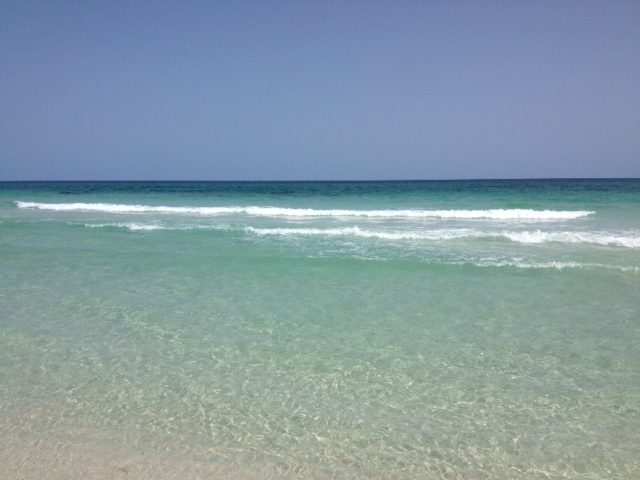
by Rick O'Connor | Jul 17, 2015
The air temperatures are in the high ‘90’s and the heat indices are reaching over 100°F; heck the inland water temperatures are in the high ‘80’s – it’s just hot out there! But our barrier island wildlife friends are doing okay, they have had to deal with this many times before. Deep burrows and nocturnal movement lead the list of behavior adaptations to cope but some still scurry around during daylight hours.
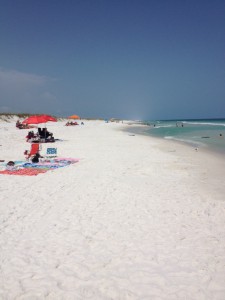
People visiting the Gulf coast during the summer.
I typically begin my monthly hikes along the Gulf shore to see what is out and about; this month there were humans… and lots of them. This is the time of year that vacationers visit our islands. Traffic is bad, nowhere to park, long lines, etc. But it is part of living on the Gulf coast. We are glad to have visitors to our part of the state. We do ask that each evening they take their chairs, tents, and trash with them. Have fun.

This plant, Redroot, grows in the wetter areas of the secondary dune.
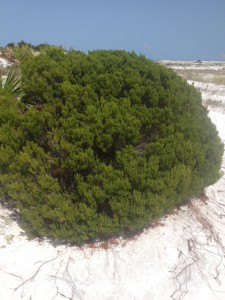
Seaside Rosemary
During these hot days of summer this flower was blooming all throughout the freshwater bogs of the secondary dunes. The plant is called REDROOT and it is really pretty. I did not see any insects near it but it was in the warm part of the day that I made my hike this month. The round shaped SEASIDE ROSEMARY is one of my favorite plants on the island. The odor it gives off reminds me of camping out there when I was a kid and of the natural beach in general. I have been told that Native Americans did use it when cooking, but can’t verify that. This is a neat plant either way. I believe there are male and female plants in this species and they have a low tolerance of fire and vehicle traffic.

The new, young seeds of the common sea oat.
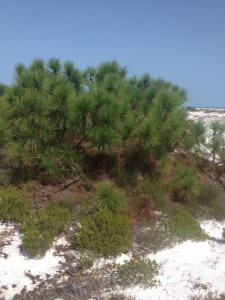
Though it appears small, this is the same species of pine that grows tall inland.
The most famous plant on our barrier islands is the SEA OAT. However most think of them in the primary dune fields only. They actually grow all across the island as long as their seeds fall in a place where the wind is good, usually at the tops of dunes. As many know the roots and rhizomes of this plant are important in stabilizing the dunes, hence the reason why in most states it is illegal to remove any part of the plant. This PINE is the same type found growing 40 feet up in your yard but here on the beach salt spray and wind stunt their growth. Also the moving sand covers much of the trunk, making the tree appear much smaller than it really is. Pines are quite common on the island.
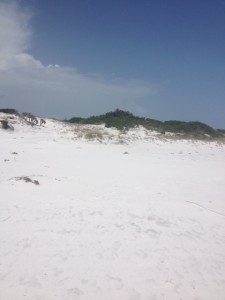
The tall trees are covered by quartz sand forming the tertiary dune system.
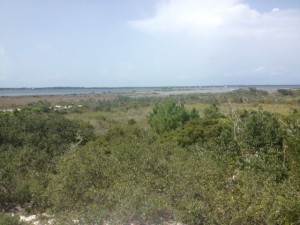
The expanse of marshes that make up Big Sabine on Santa Rosa Island.
The large trees of the barrier island system are typically found in the TERTIARY DUNE field. Here we see pine, oak, and magnolia all growing forming dunes that can reach 50 feet high in some places. Behind large tertiary dunes are the marshes of BIG SABINE. These marsh systems are some of the most biologically productive systems on the planet. 95% of our commercially valuable seafood species spend most, if not all, of their lives here. We will focus on this ecosystem in another edition of this series Discovering the Panhandle.
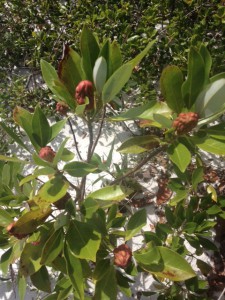
The red cones of the Sweet bay identify this as a relative of the magnolia.

The “mystery tracks” we have been seeing since January now show the small tracks of a mammal; probably armadillo.
This SWEET BAY is a member of the magnolia family and the small red cones show why. I had not seen the cones until now, so guess they like the heat and rain. WE HAVE SOLVED THE MYSTERY TRACK… knew we would. If you have read the other additions in this series you may recall we have found a track that appeared to be a “slide” coming out of the marsh and into a man-made pond from the old hatchery. Never could determine what was causing this but saw it each month of the year. However this month you could see the individual tracks of a mammal; I am guessing armadillo but could be opossum or raccoon as well. Cool… got that one behind us. On to other discoveries.
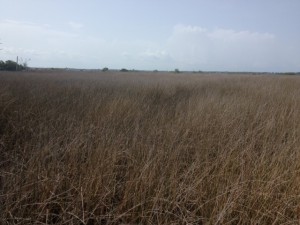
Acres and acres of Black Needlerush indicate this is a salt marsh.
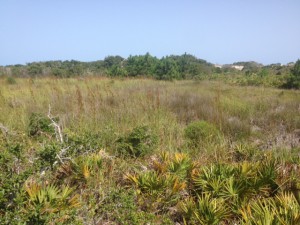
Bulrush and other plants indicate that this is not salt water, but a freshwater marsh.
Marshes differ from swamps in that they are predominantly grasses, not trees. Salt marshes, as you would expect, have salt water. Fresh water the opposite… yep. The photo on the left is the salt marsh. The grass species are different and help determine if the water is fresh or brackish. Next year we will do a whole series in this ecosystem – it is pretty cool.
Until next month… enjoy our barrier islands.




















